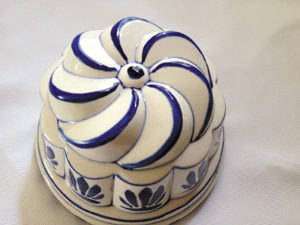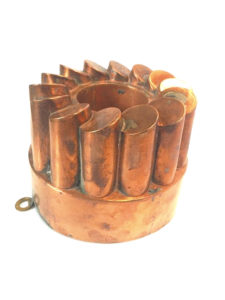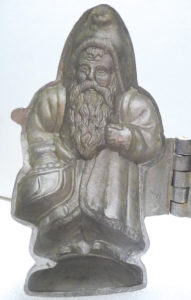 By Anne Gilbert
By Anne Gilbert Holidays are the time when fancy food molds prove their worth, dressing up everything from cranberry sauce to fish mold appetizers. There couldn’t be a better time to start a collection. The variety ranges from elegant ceramic culinary molds made in England by Wedgwood, Staffordshire and other English potters to humble American pottery and pewter.
Historically, gelatin molds were in use in the 18th century. However, the most elegant molds were for the desert course. Sugar, expensive and a status symbol at the time, was turned into spectacular, edible sculptures. By the late 19th century elaborate molded aspics, jellies and deserts graced the tables of the wealthy.
In 19th century America food molds for sponge cakes and cornbreads were country style, made of redware, yellowware and Rockingham. The embossed design was impressed on the top of the loaf. Few have potters names.
 During the 1800s wood molds with carved designs were used for cookies and butter. Copper molds were also popular. From the 17th century and into the 1920s, in some areas, butter was made at home. Both dairy farmers marked the butter with a design. Early butter stamps were chip carved by the farmers. By the end of the 19th century, designs were pressed by machine. Collectors look for those with “Pennsylvania Dutch” motifs with hearts. Eagle stamps can fetch over a hundred dollars at auction. There are even fraternal order designs such as Freemason symbols.
During the 1800s wood molds with carved designs were used for cookies and butter. Copper molds were also popular. From the 17th century and into the 1920s, in some areas, butter was made at home. Both dairy farmers marked the butter with a design. Early butter stamps were chip carved by the farmers. By the end of the 19th century, designs were pressed by machine. Collectors look for those with “Pennsylvania Dutch” motifs with hearts. Eagle stamps can fetch over a hundred dollars at auction. There are even fraternal order designs such as Freemason symbols. By the late 19th century butter stamps were also being made of ceramics as well as glass and brass.
CLUES: Butter molds and stamps have been reproduced since the 1976 Bicentennial. Santa molds in metals have been reproduced.
Don’t overpay for molds before doing research. Check out current books on the subject.
















Follow Us